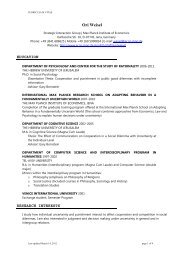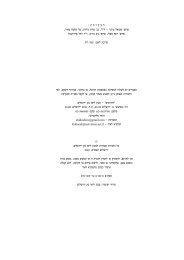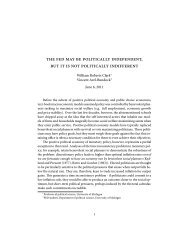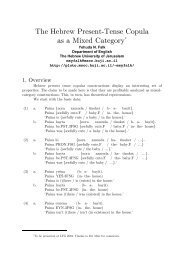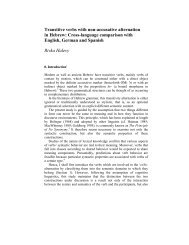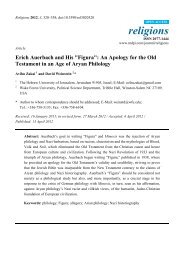Routine and the Perception of Time - Pluto Huji Ac Il
Routine and the Perception of Time - Pluto Huji Ac Il
Routine and the Perception of Time - Pluto Huji Ac Il
Create successful ePaper yourself
Turn your PDF publications into a flip-book with our unique Google optimized e-Paper software.
546<br />
44.80) than did participants in <strong>the</strong> routine condition (M 128.89<br />
mm, SD 29.62). The difference between <strong>the</strong> means <strong>of</strong> <strong>the</strong><br />
routine <strong>and</strong> nonroutine conditions was statistically significant,<br />
t(36) 3.18, p .01, 2 .22.<br />
The groups performed <strong>the</strong> same kind <strong>of</strong> task in both conditions.<br />
The number <strong>of</strong> segments was equal; only <strong>the</strong> nature <strong>of</strong> <strong>the</strong> task—<br />
routine versus nonroutine—was different. Thus, <strong>the</strong> results indicate<br />
that retrospective duration estimation was affected by routine,<br />
even when <strong>the</strong> number <strong>of</strong> segments was kept constant. Presumably,<br />
<strong>the</strong> contextual change occurring at <strong>the</strong> beginning <strong>of</strong> each<br />
segment in <strong>the</strong> nonroutine task increased <strong>the</strong> salience <strong>of</strong> <strong>the</strong> segmentation.<br />
The hypo<strong>the</strong>sis that routine would result in a shorter<br />
time estimation than would nonroutine was confirmed.<br />
Study 3: Prospective <strong>and</strong> Retrospective <strong>Time</strong> Estimations<br />
in <strong>Routine</strong> <strong>and</strong> Nonroutine Tasks<br />
Wood, Quinn, <strong>and</strong> Kashy (2002), in two recent diary studies,<br />
showed that when participants were engaged in habitual behavior,<br />
<strong>the</strong>ir thoughts drifted to issues unrelated to <strong>the</strong> behavior. When<br />
<strong>the</strong>y were involved in nonhabitual behavior, participants’ thoughts<br />
corresponded to <strong>the</strong>ir behavior. The authors suggested that thought<br />
is necessary to guide a nonhabitual action but is less necessary<br />
when one is performing a habitual action. Because attentional<br />
resources are limited, a nonroutine task will dem<strong>and</strong> more attention<br />
than a routine task, thus leaving less attention available to<br />
keep track <strong>of</strong> time. We suggest that when using <strong>the</strong> retrospective<br />
paradigm <strong>of</strong> time estimation on routine activities, people go back<br />
to <strong>the</strong> remembered elapsed period <strong>and</strong> remember it as being<br />
shorter, possibly because <strong>of</strong> <strong>the</strong> lack <strong>of</strong> change.<br />
People may think intuitively that because routine tasks are<br />
sometimes very boring <strong>and</strong> hence seem to take “forever,” time<br />
would not appear to pass quickly. We believe that this intuition can<br />
be proved right if people keep thinking about time while <strong>the</strong>y are<br />
performing a routine task. However, different processes characterize<br />
prospective <strong>and</strong> retrospective judgments. Prospective estimation<br />
involves attention to time. In routine tasks, more processing<br />
capacity is available for attending to time (Block & Zakay, 1997;<br />
Zakay, 1993; Zakay, Block, & Tsal, 1998).<br />
It follows that routine may have opposite effects on prospective<br />
<strong>and</strong> retrospective time estimation tasks. The same period <strong>of</strong> time<br />
that people remember in a retrospective method as being shorter in<br />
<strong>the</strong> routine condition would be estimated to be longer when assessed<br />
prospectively because <strong>of</strong> <strong>the</strong> routine. This prediction was<br />
tested in <strong>the</strong> present study.<br />
Method<br />
Participants. Ninety-three male <strong>and</strong> female undergraduate students<br />
between 20 <strong>and</strong> 25 years <strong>of</strong> age volunteered to participate in a memory<br />
experiment. They were r<strong>and</strong>omly assigned to one <strong>of</strong> four conditions:<br />
prospective–routine condition (20 participants), prospective–nonroutine<br />
condition (19 participants), retrospective–routine condition (27 participants),<br />
<strong>and</strong> retrospective–nonroutine condition (27 participants). Participants<br />
in <strong>the</strong> prospective conditions were told that <strong>the</strong>y would be asked to<br />
estimate <strong>the</strong> duration <strong>of</strong> <strong>the</strong> experiment.<br />
Materials <strong>and</strong> procedure. In a procedure similar to that <strong>of</strong> Experiment<br />
2, participants were given a list <strong>of</strong> 20 rows with 38 symbols each. The lists,<br />
except for underlining, were identical in all conditions. In <strong>the</strong> routine<br />
conditions, <strong>the</strong> underlined symbol was always X in all segments. In <strong>the</strong><br />
AVNI-BABAD AND RITOV<br />
nonroutine conditions, <strong>the</strong> underlined symbols were different in each<br />
segment, but <strong>the</strong> number <strong>of</strong> times <strong>the</strong>y appeared was <strong>the</strong> same as <strong>the</strong><br />
number <strong>of</strong> times <strong>the</strong> symbol X appeared in <strong>the</strong> equivalent segment <strong>of</strong> <strong>the</strong><br />
routine conditions. The procedure differed from Study 2 only in that<br />
participants in <strong>the</strong> prospective conditions were told that <strong>the</strong>y would be<br />
asked to estimate <strong>the</strong> time duration <strong>of</strong> <strong>the</strong> experiment.<br />
Results <strong>and</strong> Discussion<br />
As hypo<strong>the</strong>sized, people remembered <strong>the</strong> time spent as being<br />
shorter in <strong>the</strong> routine condition only when looking back (retrospective<br />
time estimation) but not when looking ahead at <strong>the</strong> time<br />
(prospective time estimation). Table 1 presents <strong>the</strong> mean time<br />
estimations <strong>of</strong> <strong>the</strong> four groups in <strong>the</strong> 2 2 design.<br />
In <strong>the</strong> 2 2 ANOVA, none <strong>of</strong> <strong>the</strong> main effects (for <strong>the</strong><br />
prospective <strong>and</strong> retrospective <strong>and</strong> <strong>the</strong> routine <strong>and</strong> nonroutine conditions)<br />
were significant, with Fs 1. As predicted, <strong>the</strong> interaction<br />
effect was highly significant, F(1, 89) 12.73, MSE 2,366, p <br />
.001, 2 .125. <strong>Routine</strong> resulted in shorter time judgments than<br />
did nonroutine in <strong>the</strong> remembered conditions, replicating <strong>the</strong> findings<br />
<strong>of</strong> Study 2 above, F(1, 89) 4.96, p .03, 2 .053, for <strong>the</strong><br />
comparison <strong>of</strong> <strong>the</strong> two retrospective conditions. The pattern was<br />
reversed in <strong>the</strong> prospective conditions where, as hypo<strong>the</strong>sized,<br />
routine resulted in longer time estimations than did nonroutine,<br />
F(1, 89) 7.79, p .006, 2 .080, for <strong>the</strong> comparison <strong>of</strong> <strong>the</strong><br />
two prospective conditions. Apparently, when one thinks about <strong>the</strong><br />
clock while on a routine job, time is perceived as being longer than<br />
it is perceived as being in a nonroutine job. This result is compatible<br />
with <strong>the</strong> assumption that on a changing, nonroutine job, less<br />
attention is focused on temporal information <strong>and</strong> people experience<br />
time as passing relatively quickly.<br />
Study 4: <strong>Routine</strong>—The Positive <strong>Time</strong>-Order Error<br />
The positive time-order error was examined in a lab experiment<br />
along with o<strong>the</strong>r effects <strong>of</strong> repetition that are typical <strong>of</strong> a routine.<br />
While conducting ano<strong>the</strong>r study, Babad, Avni-Babad, <strong>and</strong><br />
Rosenthal (2003) observed participants viewing a set <strong>of</strong> video clips<br />
depicting teachers’ nonverbal behavior, <strong>and</strong> it became apparent<br />
that <strong>the</strong> participants’ behavior changed as <strong>the</strong> viewing advanced.<br />
As soon as <strong>the</strong> participants became familiar with <strong>the</strong> procedure,<br />
<strong>the</strong>y developed a “pr<strong>of</strong>essional routine” that was evident in <strong>the</strong><br />
shorter time needed for writing <strong>the</strong>ir ratings <strong>and</strong> <strong>the</strong> greater confidence<br />
<strong>of</strong> <strong>the</strong>ir decisions.<br />
The same set <strong>of</strong> teachers’ video clips was used in <strong>the</strong> present<br />
study, but participants were instructed “to remember as much as<br />
possible” because it was a memory experiment. It was hypo<strong>the</strong>sized<br />
that <strong>the</strong> duration judgments <strong>of</strong> different parts would be<br />
Table 1<br />
Means <strong>and</strong> St<strong>and</strong>ard Deviations <strong>of</strong> <strong>Time</strong> Estimations (in<br />
Millimeters)<br />
Condition<br />
Prospective Retrospective<br />
M SD M SD<br />
Total M<br />
<strong>Routine</strong> 161.7 63.3 118.3 43.0 136.7<br />
Nonroutine 118.2 48.3 147.7 41.1 135.5<br />
Total M 140.5 133.0 136.1



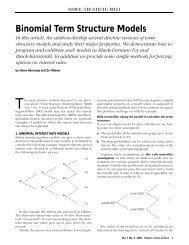
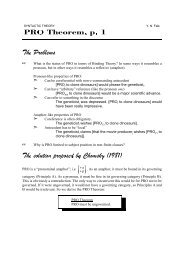
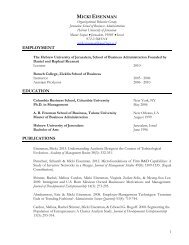
![CV [PDF] - Pluto Huji Ac Il](https://img.yumpu.com/18174585/1/190x245/cv-pdf-pluto-huji-ac-il.jpg?quality=85)

